Interval Power Flow Analysis Considering Interval Output of Wind Farms through Affine Arithmetic and Optimizing-Scenarios Method
Abstract
:1. Introduction
- We first proposed the IPFWF model, during which the uncertainties of generation from a wind farm were expressed by intervals. This model is aimed at obtaining the ranges of the power flow results of power grids incorporating wind farms with interval power generation. Considering differences among the wind farms’ operation conditions, we considered three types of wind farms in the proposed model.
- We modified the AA-based method and employed it to handle the proposed model. The AA-based method is a previously proposed method for solving the interval power flow model without considering wind farms. Here, the relationship between the reactive power and active power generation of wind farms is considered in the affine arithmetic computation. To solve the IPFWF model, minimum and maximum optimization models are established to contract the noise elements in affine arithmetic forms, and thus the results of load flow variable intervals are acquired.
- The OSM was employed here to acquire the intervals of the variables from the IPFWF model. The OSM builds two types of optimization models to acquire ranges of the load voltage magnitudes, bus angles, as well as the active line power flows of the IPFWF model. Three types of constraints of wind control modes were considered in the optimization models of the OSM, so as to imitate the operation features of wind farms. Meanwhile, the voltage recovery processes and limits of reactive power of generators were considered.
- We compared the results acquired using the AA-based method and OSM in two case studies with those acquired by the MCS, to demonstrate the advantages and effectiveness of the proposed methods, as well as validating their applicability of solving larger systems.
2. Mathematical Formulations of the Problem
2.1. Wind Farm Models
2.1.1. Modeling of the Output Wind Power Generation
2.1.2. Fixed Speed and Constant Frequency Control
2.1.3. Constant Power Factor Control Mode
2.1.4. Constant Voltage Control Mode
2.2. Interval Power Flow with Wind Farms Model
3. Solution to the IPFWF Model
3.1. Solution of the IPFWF Model by AA-Based Method
3.1.1. Introduction of AA
3.1.2. Solution of the IPFWF through AA
3.2. Solution of the IPFWF Model by OSM
4. Simulation Results
4.1. IEEE 30-Bus System
4.2. IEEE 118-Bus System
5. Conclusions
Author Contributions
Funding
Conflicts of Interest
Appendix A
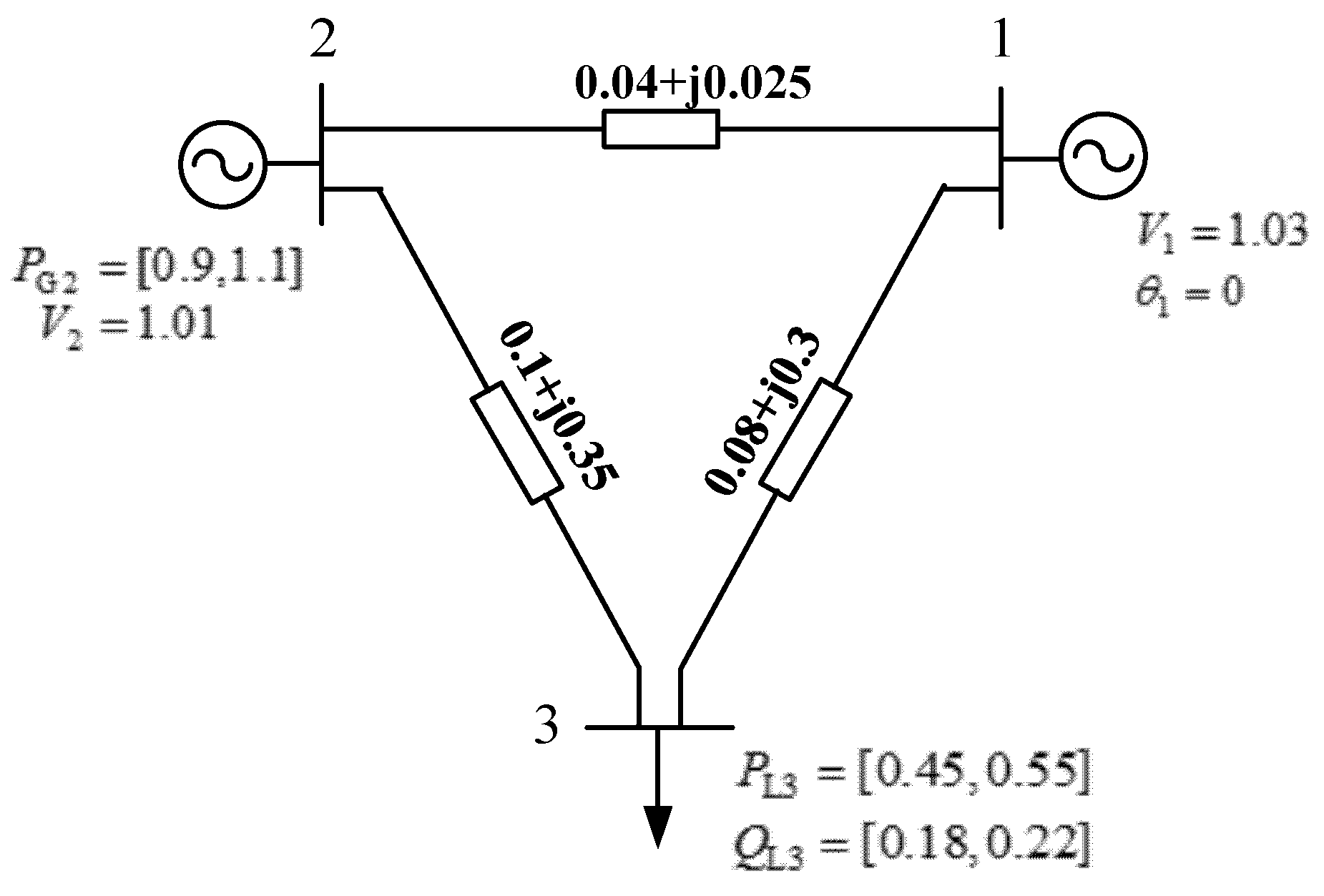
References
- Li, Z.; Ye, L.; Zhao, Y.; Song, X.; Teng, J.; Jin, J. Short-term wind power prediction based on extreme learning machine with error correction. Prot. Control Mod. Power Syst. 2016, 1, 1–8. [Google Scholar] [CrossRef]
- Chen, Y.; Wen, J.; Cheng, S. Probabilistic load flow method based on Nataf transformation and Latin hypercube sampling. IEEE. Sustain. Energy 2013, 4, 294–301. [Google Scholar] [CrossRef]
- Zhou, G.; Bo, R.; Chien, L.; Zhang, X.; Yang, S.; Su, D. GPU-Accelerated Algorithm for On-line probabilistic power flow. IEEE Trans. Power Syst. 2018, 33, 1132–1135. [Google Scholar] [CrossRef]
- Hong, Y.Y.; Lin, F.J.; Yu, T.H. Taguchi method-based probabilistic load flow studies considering uncertain renewables and loads. IET Renew. Power Gener. 2016, 10, 221–227. [Google Scholar] [CrossRef]
- Yuan, Y.; Zhou, J.; Ju, P. Probabilistic load flow computation of a power system containing wind farms using the method of combined cumulants and Gram-Charlier expansion. IET Renew. Power Gener. 2011, 5, 448–454. [Google Scholar] [CrossRef]
- Fan, M.; Vittal, V.; Heydt, G.T. Probabilistic power flow studies for transmission systems with photovoltaic generation using cumulants. IEEE Trans. Power Syst. 2012, 27, 2251–2261. [Google Scholar] [CrossRef]
- Williams, T.; Crawford, C. Probabilistic load flow modeling comparing maximum entropy and Gram-Charlier probability density function reconstructions. IEEE Trans. Power Syst. 2013, 28, 272–280. [Google Scholar] [CrossRef]
- Xiao, Q.; He, Y.; Chen, K.; Yang, Y.; Lu, Y. Point estimate method based on univariate dimension reduction model for probabilistic power flow computation. IET Gener. Trans. Distrib. 2017, 11, 3522–3531. [Google Scholar] [CrossRef]
- Saunders, C.S. Point estimate method addressing correlated wind power for probabilistic optimal power flow. IEEE Trans. Power Syst. 2014, 29, 1045–1054. [Google Scholar] [CrossRef]
- Liu, C.; Sun, K.; Wang, B. Probabilistic power flow analysis using multi-dimensional Holomorphic embedding and generalized cumulants. IEEE Trans. Power Syst. 2018, 33, 7132–7142. [Google Scholar] [CrossRef]
- Zhang, L.; Cheng, H.; Zhang, S. A novel point estimate method for probabilistic power flow considering correlated nodal power. In Proceedings of the 2014 IEEE PES General Meeting|Conference & Exposition, National Harbor, MD, USA, 27–31 July 2014; pp. 1–5. [Google Scholar]
- Aien, M.; Khajeh, M.G.; Rashidinejad, M. Probabilistic power flow of correlated hybrid wind-photovoltaic power systems. IET Renew. Power Gener. 2014, 8, 649–658. [Google Scholar] [CrossRef]
- Zuluaga, C.D.; Alvarez, M.A. Bayesian probabilistic power flow analysis using Jacobian approximate Bayesian computation. IEEE Trans. Power Syst. 2018, 33, 5217–5225. [Google Scholar] [CrossRef]
- Yu, H.; Rosehart, B. Probabilistic power flow considering wind speed correlation of wind farms. In Proceedings of the 17th Power Systems Computation Conference, Stockholm, Sweden, 22–26 August 2011; pp. 1–7. [Google Scholar]
- Hajian, M.; Rosehart, W.D.; Zareipour, H. Probabilistic power flow by Monte Carlo simulation with Latin supercube sampling. IEEE Trans. Power Syst. 2013, 28, 1550–1559. [Google Scholar] [CrossRef]
- Baghaee, H.R.; Mirsalim, M.; Gharehpetian, G.B. Fuzzy unscented transform for uncertainty quantification of correlated wind/PV microgrids: Possibilistic–probabilistic power flow based on RBFNNs. IET Renew. Power Gener. 2017, 11, 867–877. [Google Scholar] [CrossRef]
- Melhorn, A.C.; Dimitrovski, A. Three-phase probabilistic load flow in radial and meshed distribution networks. IET Gener. Trans. Distrib. 2015, 9, 2743–2750. [Google Scholar] [CrossRef]
- Wang, Z.; Alvarado, F.L. Interval arithmetic in power flow analysis. IEEE Trans. Power Syst. 1992, 7, 1341–1349. [Google Scholar] [CrossRef] [Green Version]
- Mori, H.; Yuihara, A. Calculation of multiple power flow solutions with the Krawczyk method. In Proceedings of the 1999 IEEE International Symposium on Circuits and Systems VLSI (Cat. No.99CH36349), Orlando, FL, USA, 30 May–2 June 1999; pp. 94–97. [Google Scholar]
- De Figueiredo, L.H.; Stolfi, J. Affine arithmetic: Concepts and applications. Numer. Algorithm. 2004, 37, 147–158. [Google Scholar] [CrossRef]
- Vaccaro, A.; Canizares, C.; Villacci, D. An affine arithmetic-based methodology for reliable power flow analysis in the presence of data uncertainty. IEEE Trans. Power Syst. 2010, 25, 624–632. [Google Scholar] [CrossRef]
- Pirnia, M.; Canizares, C.A.; Bhattacharya, K.; Vaccaro, A. An affine arithmetic method to solve the stochastic power flow problem based on a mixed complementarity formulation. In Proceedings of the 2012 IEEE Power and Energy Society General Meeting, San Diego, CA, USA, 22–26 July 2012; pp. 1–7. [Google Scholar]
- Vaccaro, A.; Cañizares, C.A.; Bhattacharya, K. A range arithmetic-based optimization model for power flow analysis under interval uncertainty. IEEE Trans. Power Syst. 2013, 28, 1179–1186. [Google Scholar] [CrossRef]
- Zhang, C.; Chen, H.; Ngan, H.; Yang, P.; Hua, D. A mixed interval power flow analysis under rectangular and polar coordinate system. IEEE Trans. Power Syst. 2017, 32, 1422–1429. [Google Scholar] [CrossRef]
- Zhang, C.; Chen, H.; Shi, K.; Qiu, M.; Hua, D.; Ngan, H. An interval power flow analysis through optimizing-scenarios method. IEEE Trans. Smart Grid 2018, 9, 5217–5226. [Google Scholar] [CrossRef]
- Zhang, C.; Chen, H.; Guo, M.; Wang, X.; Liu, Y.; Hua, D. DC power flow analysis incorporating interval input data and network parameters through the optimizing-scenarios method. Int. J. Electr. Power Energy Syst. 2018, 96, 380–389. [Google Scholar] [CrossRef]
- Ran, X.; Miao, S. Three-phase probabilistic load flow for power system with correlated wind, photovoltaic and load. IET Gener. Transm. Distrib. 2016, 10, 3093–3101. [Google Scholar] [CrossRef]
- Li, X.; Cao, J.; Lu, P. Probabilistic load flow computation in power system including wind farms with correlated parameters. In Proceedings of the 2nd IET Renewable Power Generation Conference (RPG 2013), Beijing, China, 9–11 September 2013; pp. 1–4. [Google Scholar]
- Jaoued, I.B.; Guesmi, T.; Abdallah, H.H. Power flow solution for power systems including FACTS devices and wind farms. In Proceedings of the IEEE International Conference on Sciences and Technology of Automatic Control and Computer Engineering, Sousse, Tunisia, 7 April 2014; pp. 136–139. [Google Scholar]
- Vaccaro, A.; Canizares, C.A. An affine arithmetic-based framework for uncertain power flow and optimal power flow studies. IEEE Trans. Power Syst. 2016, 32, 274–288. [Google Scholar] [CrossRef]
- Zhang, C.; Chen, H.; Ngan, H. Reactive power optimisation considering wind farms based on an optimal scenario method. IET Gener. Transm. Distrib. 2016, 10, 3736–3744. [Google Scholar] [CrossRef]
- Jin, X.; Zhang, C.; Chen, H.; Xu, X. Optimal reactive power dispatch considering wind turbines. In Proceedings of the 2014 IEEE PES Asia-Pacific Power and Energy Engineering Conference (APPEEC), Hong Kong, China, 7–10 December 2014; pp. 1–5. [Google Scholar]
- Castro, L.M.; Fuerte-Esquivel, C.R.; Tovar-Hernandez, J.H. A unified approach for the solution of power flows in electric power systems including wind farms. Electr. Power Syst. Res. 2011, 81, 1859–1865. [Google Scholar] [CrossRef]
- Feijoo, A.; Villanueva, D. Wind farm power distribution function considering wake effects. IEEE Trans. Power Syst. 2017, 32, 3313–3314. [Google Scholar] [CrossRef]
- Shi, L.B.; Weng, Z.X.; Yao, L.Z. An analytical solution for wind farm power output. IEEE Trans. Power Syst. 2014, 29, 3122–3123. [Google Scholar] [CrossRef]
- Priyadharshini, P.; Mohamed, T.A.M. Modeling and analysis of wind farms in load flow studies. In Proceedings of the 2015 International Conference on Computation of Power, Energy, Information and Communication (ICCPEIC), Chennai, India, 22–23 April 2015; pp. 364–372. [Google Scholar]
- Feijoo, A.; Villanueva, D. Four parameter models for wind farm power curves and power probability density functions. IEEE Trans. Sustain. Energy 2017, 8, 1783–1784. [Google Scholar] [CrossRef]
- Eminoglu, U.; Ayasun, S. Modeling and design optimization of variable-speed wind turbine systems. Energies 2014, 7, 402–419. [Google Scholar] [CrossRef]
- Eminoglu, U. A new model for output power calculation of variable-speed wind turbine systems. In Proceedings of the 2015 International Aegean Conference on Electrical Machines & Power Electronics (ACEMP), Side, Turkey, 2–4 September 2015; pp. 141–146. [Google Scholar]
- Sulaeman, S.; Benidris, M.; Mitra, J. A method to model the output power of wind farms in composite system reliability assessment. In Proceedings of the 2014 North American Power Symposium (NAPS), Pullman, WA, USA, 7–9 September 2014; pp. 1–6. [Google Scholar]
- Yu, H.; Rosehart, W.D. An optimal power flow algorithm to achieve robust operation considering load and renewable generation uncertainties. IEEE Trans. Power Syst. 2012, 27, 1808–1817. [Google Scholar] [CrossRef]
- Merizalde, Y.; Bonilla, L.M.; Hernández-Callejo, L.; Duque-Perez, O. Wind turbine maintenance. A review. DYNA-Ingeniería e Industria 2018, 93, 435–441. [Google Scholar] [CrossRef]
- Tian, J.; Su, C.; Soltani, M. Active power dispatch method for a wind farm central controller considering wake effect. In Proceedings of the IECON 2014—40th Annual Conference of the IEEE Industrial Electronics Society, Dallas, TX, USA, 29 October–1 November 2014; pp. 5450–5456. [Google Scholar]
- Ghosh, S.; Kamalasadan, S.; Senroy, N. Doubly fed induction generator (DFIG)-based wind farm control framework for primary frequency and inertial response application. IEEE Trans. Power Syst. 2016, 31, 1861–1871. [Google Scholar] [CrossRef]
- Liu, M.; Tso, S.K.; Cheng, Y. An extended nonlinear primal-dual interior-point algorithm for reactive-power optimization of large-scale power systems with discrete control variables. IEEE Trans. Power Syst. 2002, 17, 982–991. [Google Scholar] [CrossRef]
- Power Systems Test Case Archive. Available online: http://www.ee.washington.edu/research/pstca/ (accessed on 3 January 2018).
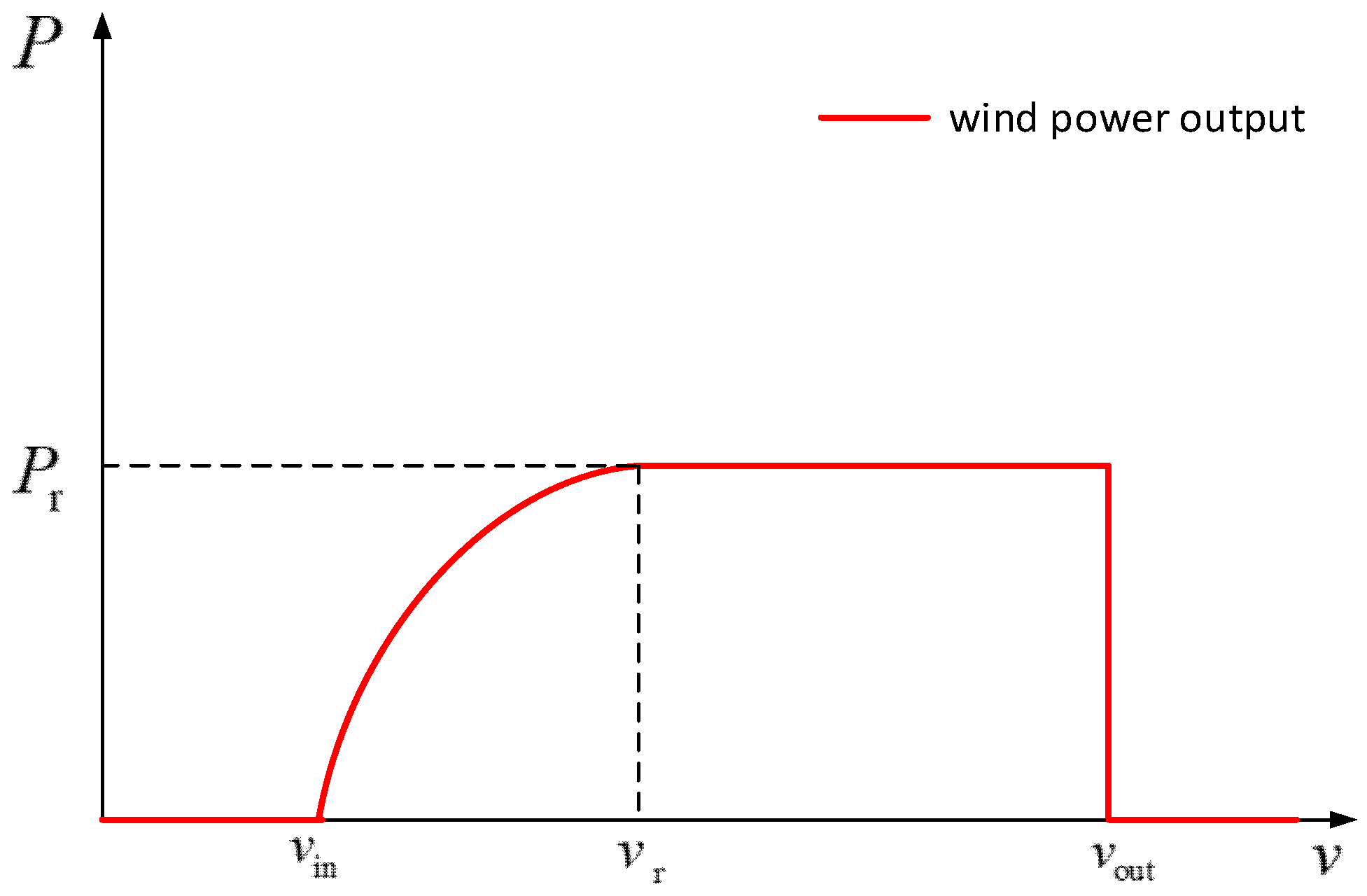
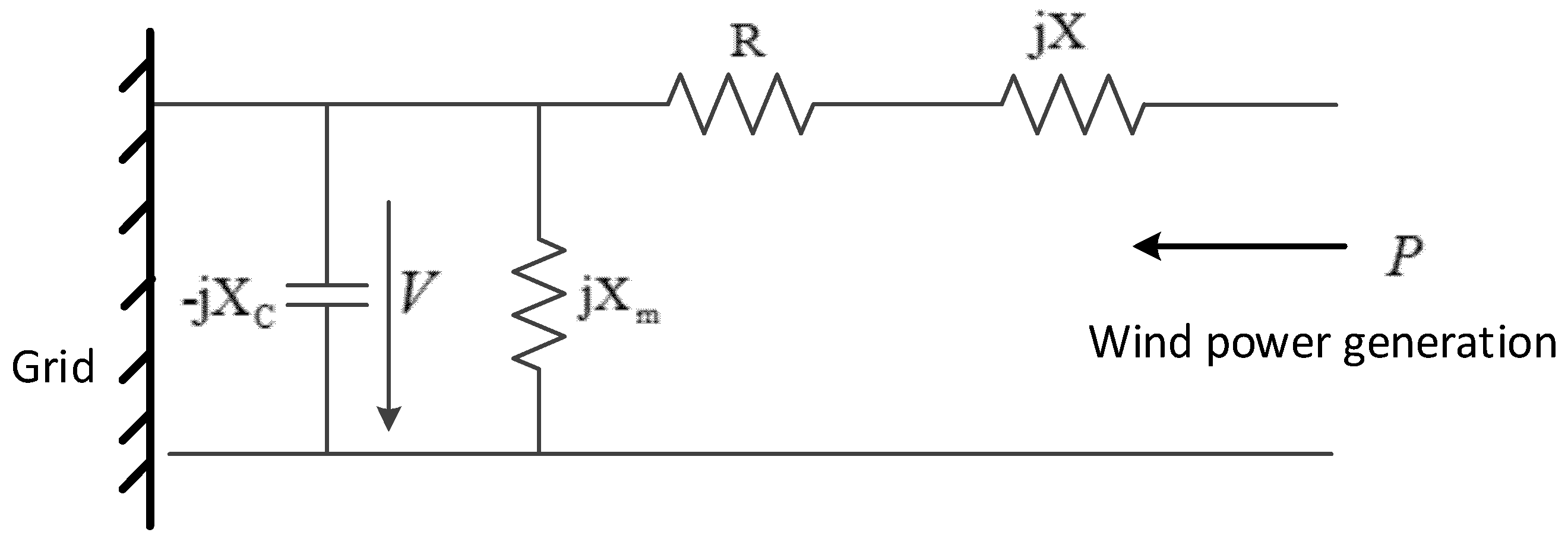

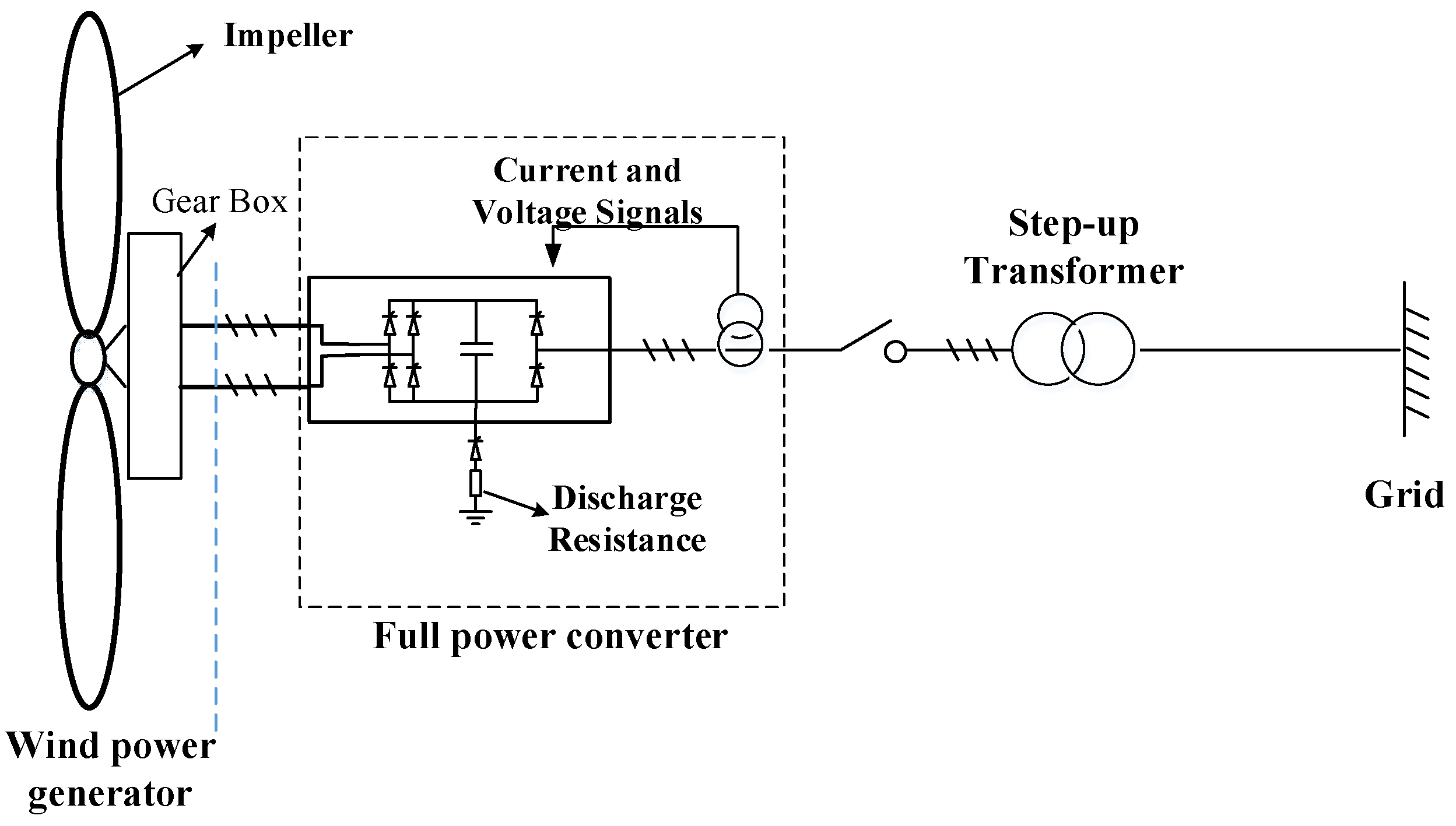


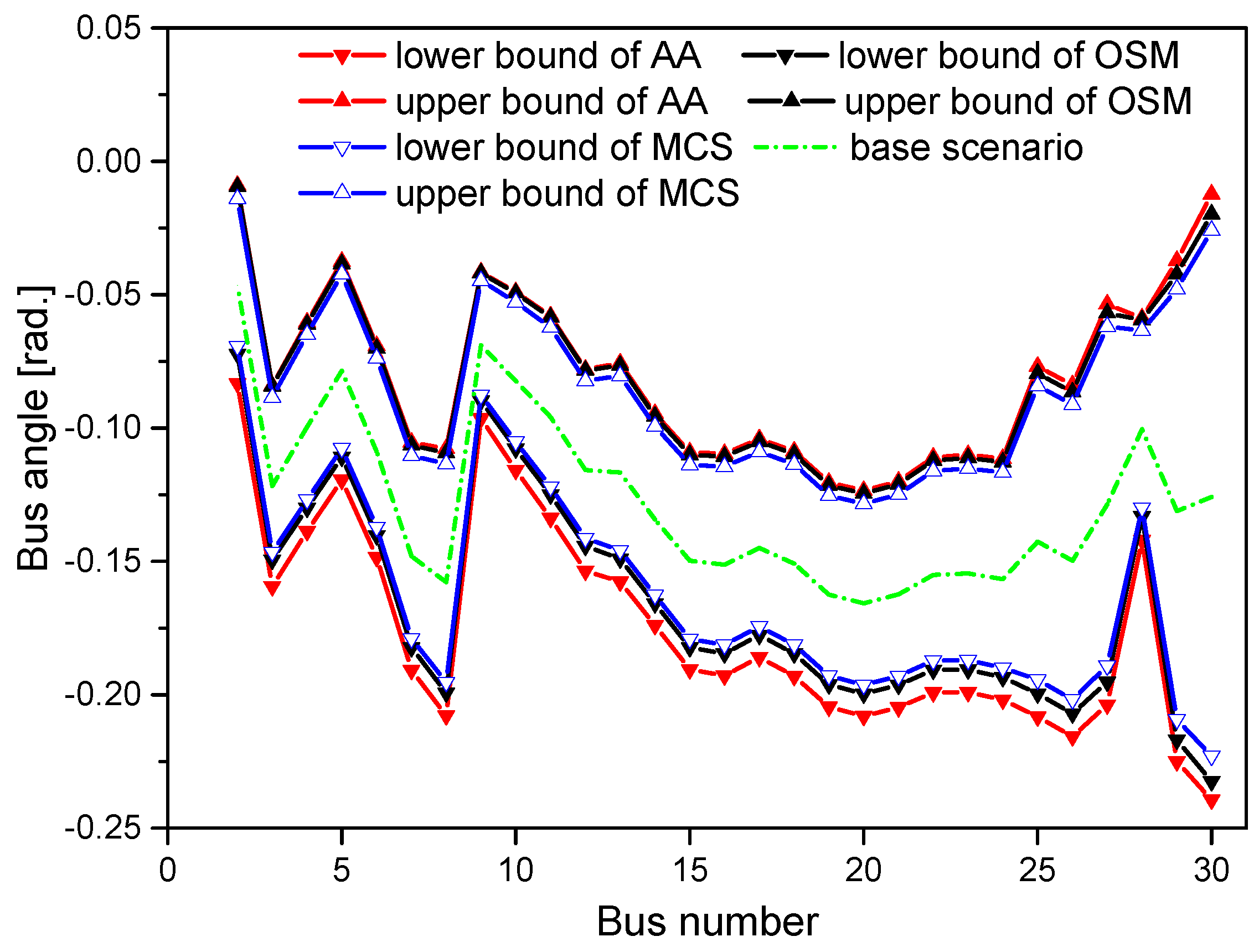
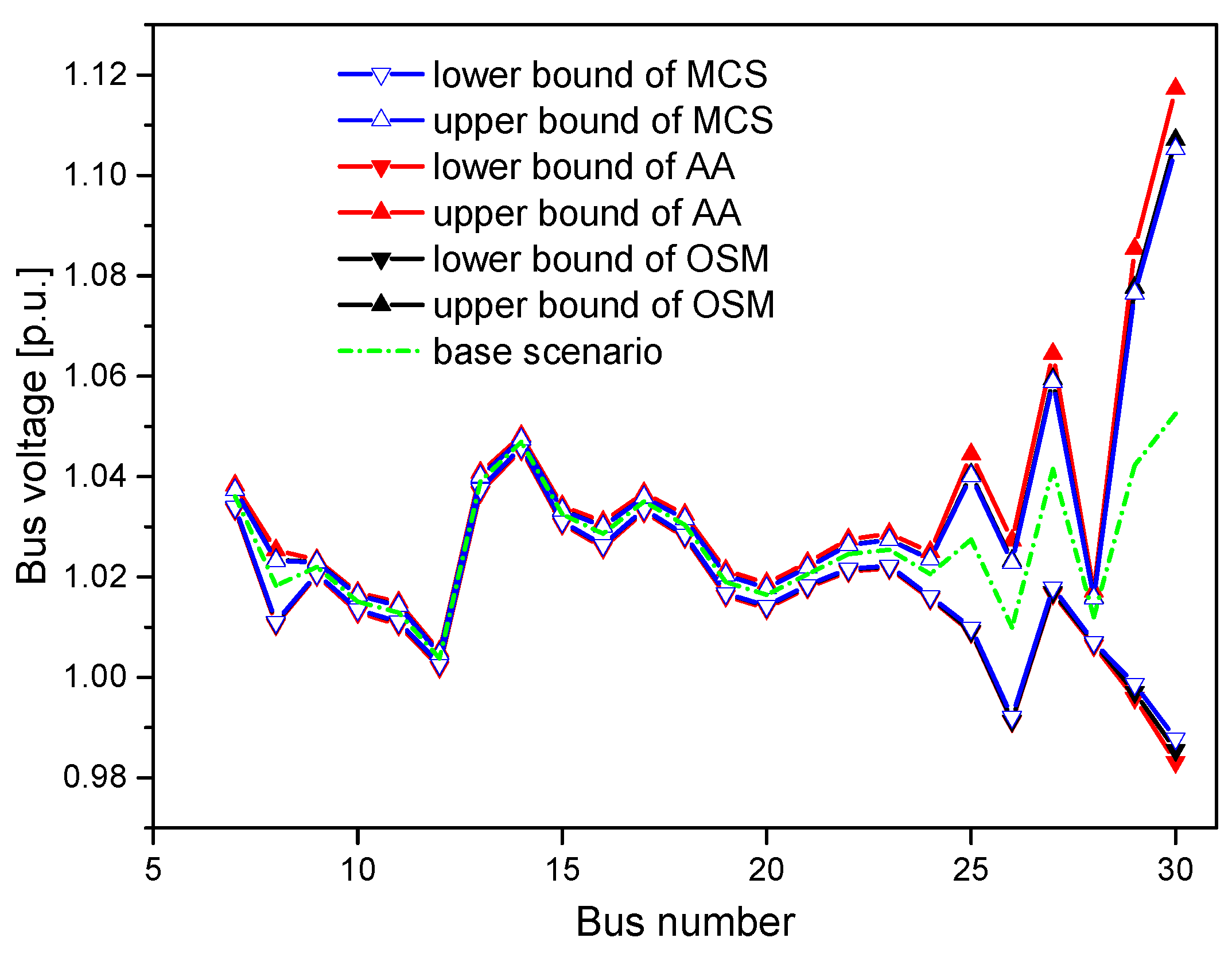
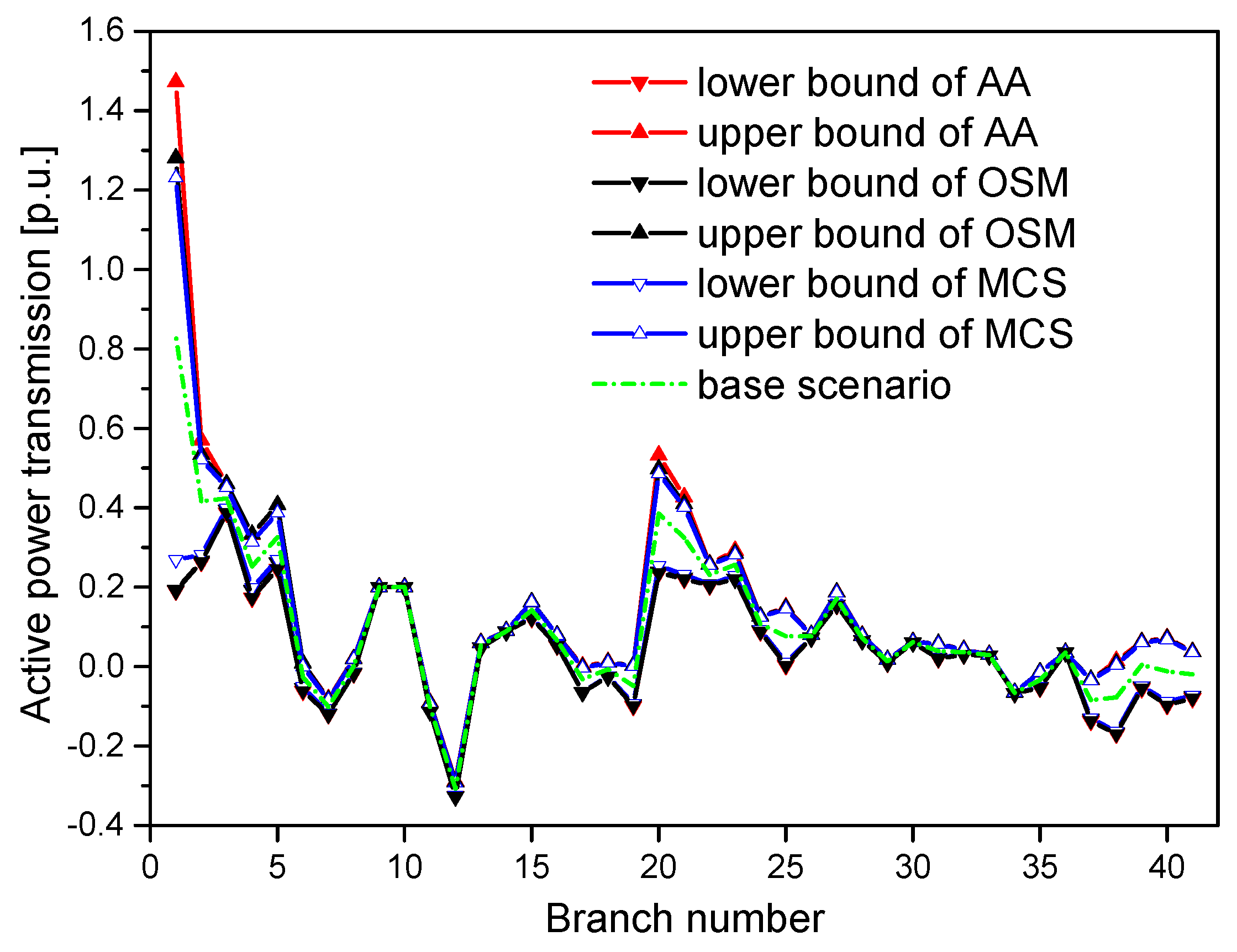

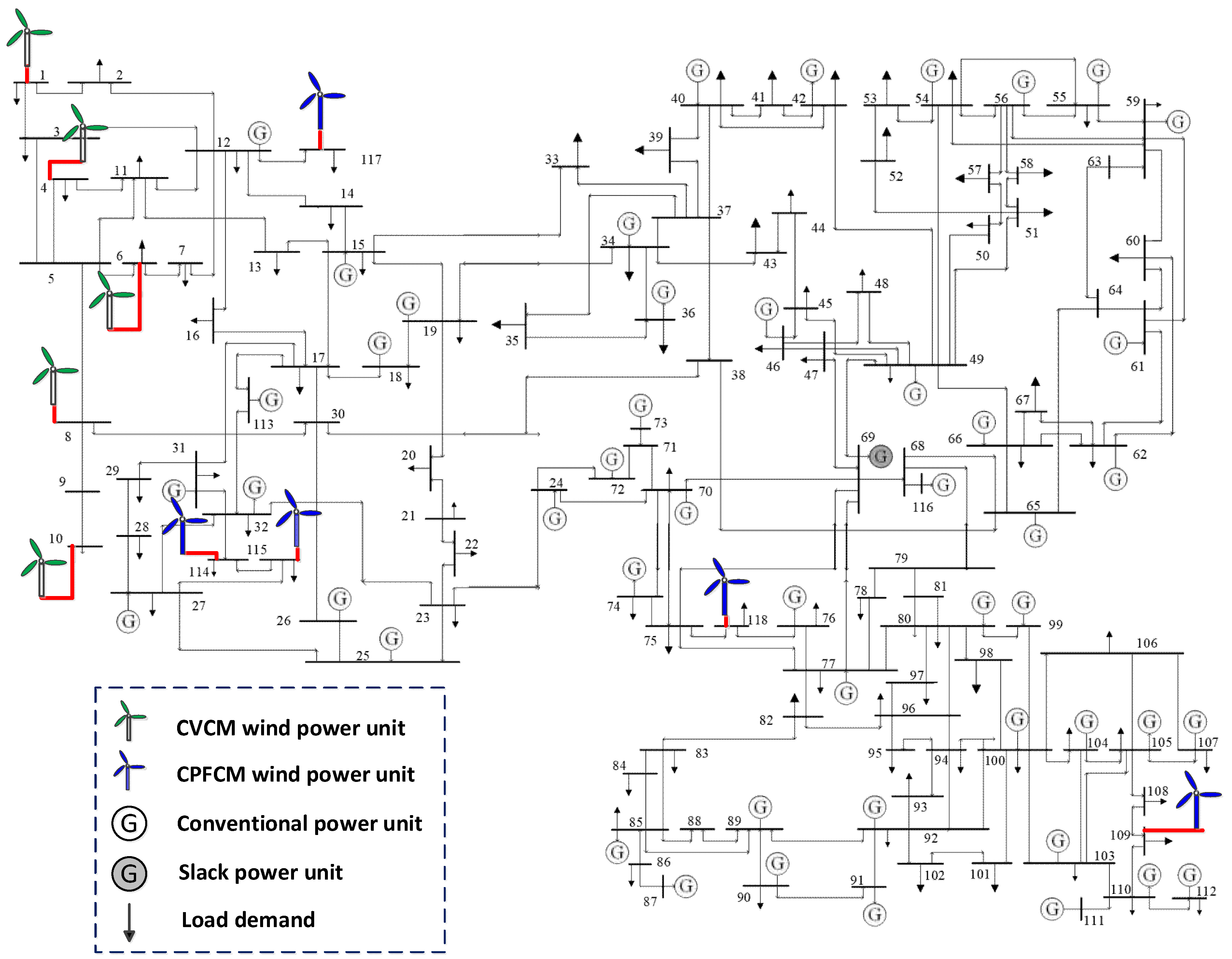
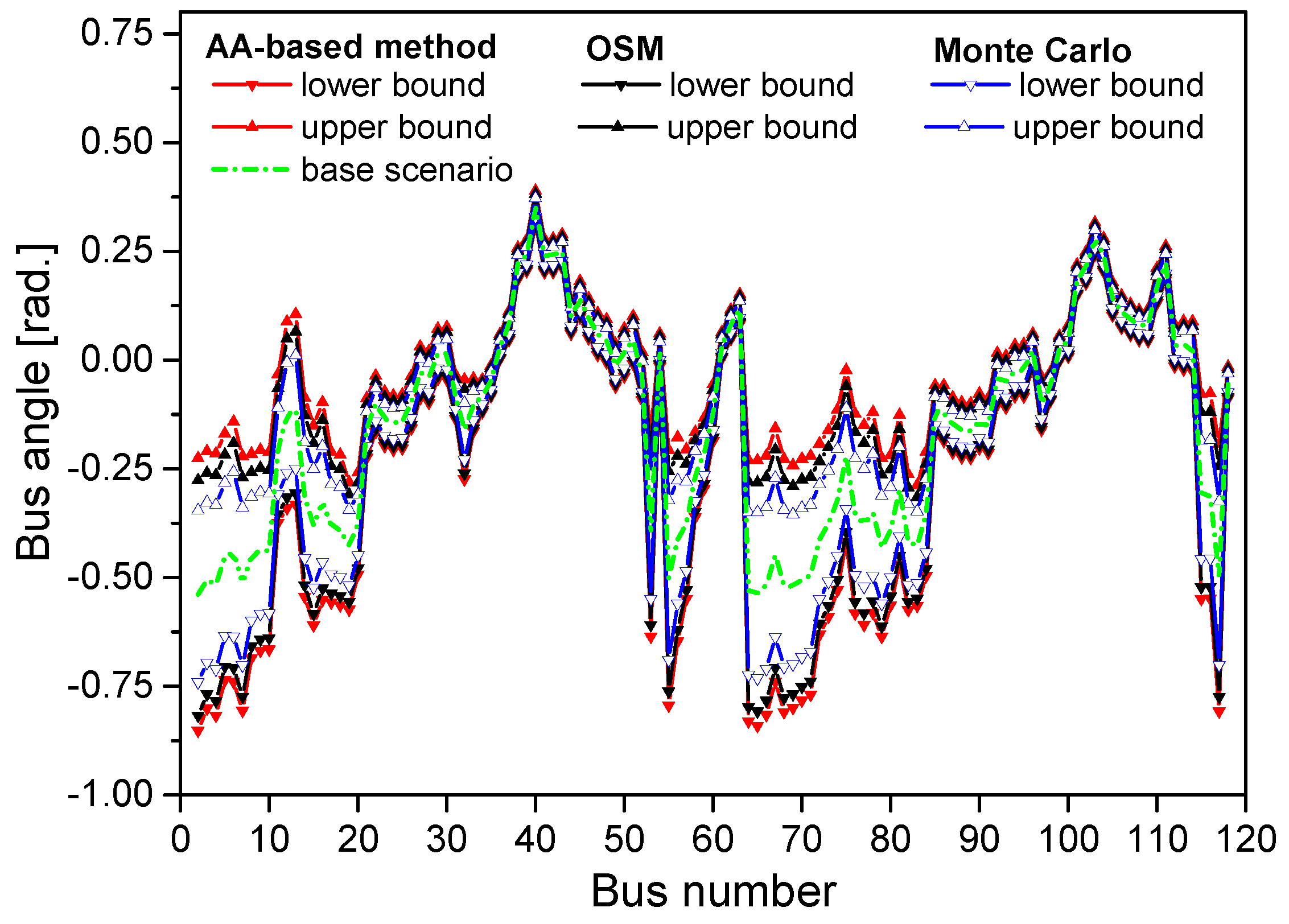
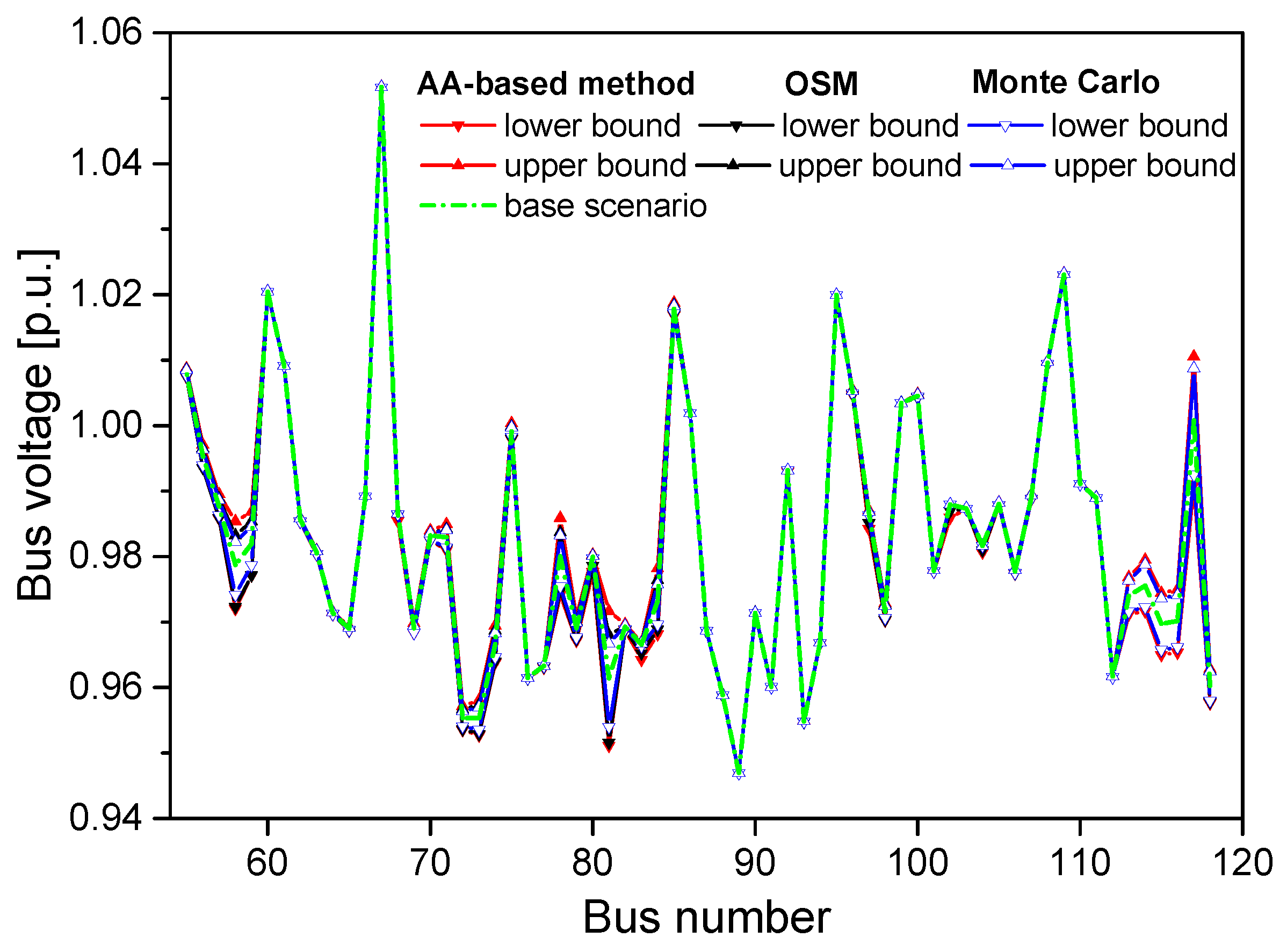

| Type | Pr (MW) | c | k | vco (m/s) | vr (m/s) | vci (m/s) |
|---|---|---|---|---|---|---|
| CPFCM | 27.56 | 7.5 | 2 | 20 | 14 | 5 |
| CVCM | 104 | 8 | 2 | 24 | 16 | 4 |
| Bus Position | Type | k | c | ||||
|---|---|---|---|---|---|---|---|
| 1 | CVCM | 5 | 14 | 20 | 50 | 2 | 7.5 |
| 4 | CVCM | 6 | 15 | 24 | 50 | 3 | 8 |
| 6 | CVCM | 4 | 16 | 21.5 | 50 | 2.5 | 8.0 |
| 8 | CVCM | 4 | 17 | 23 | 50 | 2.5 | 7.5 |
| 10 | CVCM | 4 | 15 | 24 | 50 | 2 | 8.5 |
| 109 | CPFCM | 5 | 14 | 21 | 21.2 | 2 | 7.5 |
| 114 | CPFCM | 4 | 16 | 22 | 21.2 | 2.5 | 6.5 |
| 115 | CPFCM | 6 | 16 | 23 | 21.2 | 2 | 8.5 |
| 117 | CPFCM | 5.5 | 16 | 24 | 21.2 | 2.5 | 7.5 |
| 118 | CPFCM | 5 | 15 | 20 | 21.2 | 3 | 7.0 |
© 2018 by the authors. Licensee MDPI, Basel, Switzerland. This article is an open access article distributed under the terms and conditions of the Creative Commons Attribution (CC BY) license (http://creativecommons.org/licenses/by/4.0/).
Share and Cite
Cheng, W.; Cheng, R.; Shi, J.; Zhang, C.; Sun, G.; Hua, D. Interval Power Flow Analysis Considering Interval Output of Wind Farms through Affine Arithmetic and Optimizing-Scenarios Method. Energies 2018, 11, 3176. https://doi.org/10.3390/en11113176
Cheng W, Cheng R, Shi J, Zhang C, Sun G, Hua D. Interval Power Flow Analysis Considering Interval Output of Wind Farms through Affine Arithmetic and Optimizing-Scenarios Method. Energies. 2018; 11(11):3176. https://doi.org/10.3390/en11113176
Chicago/Turabian StyleCheng, Weijie, Renli Cheng, Jun Shi, Cong Zhang, Gaoxing Sun, and Dong Hua. 2018. "Interval Power Flow Analysis Considering Interval Output of Wind Farms through Affine Arithmetic and Optimizing-Scenarios Method" Energies 11, no. 11: 3176. https://doi.org/10.3390/en11113176





